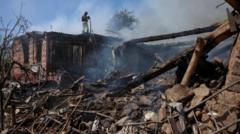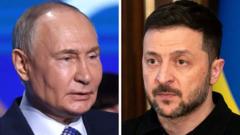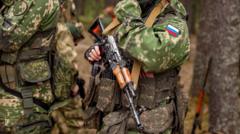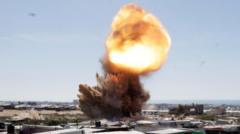In the latest diplomatic push to resolve the war in Ukraine, discussions are ongoing among officials from multiple countries, including the US and Russia. While proposals are being floated, significant gaps and opposing demands leave the chances of a successful resolution unclear.
Diplomatic Efforts to Resolve Ukraine Conflict Intensify Amid Uncertain Outcomes

Diplomatic Efforts to Resolve Ukraine Conflict Intensify Amid Uncertain Outcomes
The pace of negotiations between key world powers to end the Ukraine war is accelerating, yet the path to peace remains murky.
The diplomatic landscape surrounding the Ukraine conflict is rapidly evolving as key nations engage in intensified negotiations aimed at reaching an amicable resolution. Recent meetings in London have drawn officials from the UK, Germany, France, Ukraine, and the United States to discuss potential pathways to peace. In parallel, Donald Trump’s special envoy, Steve Witkoff, is set to meet with President Putin in Moscow for what will be his fourth discussion.
However, despite the surge in diplomatic activity, a definitive outcome remains elusive. Some time ago, the United States articulated a clear strategy for addressing the fighting—a rapid, unconditional 30-day ceasefire followed by comprehensive talks aimed at establishing a lasting settlement. Ukraine endorsed this framework, conceding a significant demand for long-term security assurances that would precede any pause in hostilities.
Russia, however, rejected this overture, asserting that there would be no cessation of violence until a series of conditions were satisfied. Specifically, President Putin emphasized the need to address the war's "root causes," particularly his concerns regarding NATO expansion and Ukraine's status as a potentially threatening entity to Russia's national security.
In recent days, various unofficial reports have shed light on a proposed ceasefire agenda; however, these details remain contested among diplomatic circles. A potential framework suggests that Russia would halt its military advance and relinquish aspirations to seize further territory in four eastern regions of Ukraine, including Luhansk, Donetsk, Zaporizhzhia, and Kherson. In exchange, the US would implicitly accept Russian control over these regions and recognize Crimea—as annexed by Russia in 2014—as part of its territory. Additionally, the proposal may see Ukraine commit to remaining outside NATO.
Central to this conversation is the contentious Zaporizhzhia nuclear power plant, which currently operates under Russian control and could be managed by the US to supply electricity to both Ukrainian territories. There is a prevailing belief among US officials that without immediate agreement on these proposals, negotiations might collapse altogether.
Yet, the viability of this plan is called into question. President Zelensky has made it unequivocally clear that Ukraine would never concede Crimea’s sovereignty. Furthermore, any such concession would likely necessitate a national referendum, which complicates matters further. European allies have similarly voiced their opposition to recognizing any Russian sovereignty over Crimea, as it would undermine established post-war international law.
Legal authorities implicate additional complications surrounding the US government's potential acknowledgment of Crimea's status due to existing congressional directives. Despite these hurdles, diplomats from the Western alliance remain hopeful, suggesting a navigable path exists if enough trust can be established among the negotiating parties.
However, major gaps remain in the proposed plan. There is no stipulation prohibiting the continued arming of Ukraine by Western nations—a key concern for Russia. Likewise, the absence of an explicit ban on the demilitarization of Ukraine raises significant questions about the feasibility of any agreement.
The proposed structure suggests the possibility of Ukraine’s EU membership while disallowing NATO accession and permitting a European peacekeeping force in western Ukraine to deter further Russian aggression. Nonetheless, ambiguity persists regarding the US commitment to support this force and the conditions under which economic sanctions against Russia might be lifted.
Despite the urgency of these discussions, notable discrepancies remain between the involved parties. Ukraine advocates for an immediate conditional ceasefire and subsequent talks, while the US seeks a quick resolution, and Russia demands intricate details found in peace accords typically drawn out over years. An old Russian saying encapsulates the current situation: "Nothing is agreed until everything is agreed." Presently, it appears that all parties remain distanced from that agreement.





















